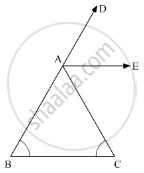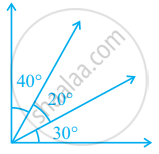Advertisements
Advertisements
प्रश्न
In ∆ABC, C = 56° C = 56° ∠B = ∠C and ∠A = 100° ; find ∠B.
उत्तर
∠A + ∠B + ∠C = 180°
⇒ 100° + ∠B + ∠B = 180°
⇒ 2∠B = 180° 100°
∠B = `(80°)/2`
∠B = 40°
∠C = ∠B = 40°
APPEARS IN
संबंधित प्रश्न
The angles of a triangle are arranged in ascending order of magnitude. If the difference
between two consecutive angles is 10°, find the three angles.
In a ΔABC, ∠ABC = ∠ACB and the bisectors of ∠ABC and ∠ACB intersect at O such that ∠BOC = 120°. Show that ∠A = ∠B = ∠C = 60°.
The exterior angles, obtained on producing the base of a triangle both way are 104° and 136°. Find all the angles of the triangle.
Is the following statement true and false :
Sum of the three angles of a triangle is 180 .
Is the following statement true and false :
A triangle can have two obtuse angles.
In the given figure, AE bisects ∠CAD and ∠B= ∠C. Prove that AE || BC.

State, if the triangle is possible with the following angles :
60°, 60°, and 50°
S is any point on side QR of a ∆PQR. Show that: PQ + QR + RP > 2PS.
The number of angles in figure is ______.
Can we have two acute angles whose sum is a straight angle? Why or why not?
